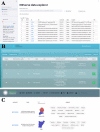Pathways to a Shiny Future: Building the Foundation for Computational Physical Chemistry and Biophysics in 2050
- PMID: 39069976
- PMCID: PMC11274290
- DOI: 10.1021/acsphyschemau.4c00003
Pathways to a Shiny Future: Building the Foundation for Computational Physical Chemistry and Biophysics in 2050
Abstract
In the last quarter-century, the field of molecular dynamics (MD) has undergone a remarkable transformation, propelled by substantial enhancements in software, hardware, and underlying methodologies. In this Perspective, we contemplate the future trajectory of MD simulations and their possible look at the year 2050. We spotlight the pivotal role of artificial intelligence (AI) in shaping the future of MD and the broader field of computational physical chemistry. We outline critical strategies and initiatives that are essential for the seamless integration of such technologies. Our discussion delves into topics like multiscale modeling, adept management of ever-increasing data deluge, the establishment of centralized simulation databases, and the autonomous refinement, cross-validation, and self-expansion of these repositories. The successful implementation of these advancements requires scientific transparency, a cautiously optimistic approach to interpreting AI-driven simulations and their analysis, and a mindset that prioritizes knowledge-motivated research alongside AI-enhanced big data exploration. While history reminds us that the trajectory of technological progress can be unpredictable, this Perspective offers guidance on preparedness and proactive measures, aiming to steer future advancements in the most beneficial and successful direction.
© 2024 The Authors. Published by American Chemical Society.
Conflict of interest statement
The authors declare no competing financial interest.
Figures

 , are shown in the inlet rectangles and
compared with publication data from the years 1998 and 2023 (N1998 and N2023,
respectively). The utilized Scopus data set is available on Zenodo
under DOI:
, are shown in the inlet rectangles and
compared with publication data from the years 1998 and 2023 (N1998 and N2023,
respectively). The utilized Scopus data set is available on Zenodo
under DOI: 

Similar articles
-
6G Networks and the AI Revolution-Exploring Technologies, Applications, and Emerging Challenges.Sensors (Basel). 2024 Mar 15;24(6):1888. doi: 10.3390/s24061888. Sensors (Basel). 2024. PMID: 38544151 Free PMC article. Review.
-
Physics-based protein structure refinement in the era of artificial intelligence.Proteins. 2021 Dec;89(12):1870-1887. doi: 10.1002/prot.26161. Epub 2021 Jun 29. Proteins. 2021. PMID: 34156124 Free PMC article.
-
Multiscale brain modeling: bridging microscopic and macroscopic brain dynamics for clinical and technological applications.Front Cell Neurosci. 2025 Feb 19;19:1537462. doi: 10.3389/fncel.2025.1537462. eCollection 2025. Front Cell Neurosci. 2025. PMID: 40046848 Free PMC article. Review.
-
The Application of Artificial Intelligence and Big Data in the Food Industry.Foods. 2023 Dec 18;12(24):4511. doi: 10.3390/foods12244511. Foods. 2023. PMID: 38137314 Free PMC article. Review.
-
Progress and opportunities of foundation models in bioinformatics.Brief Bioinform. 2024 Sep 23;25(6):bbae548. doi: 10.1093/bib/bbae548. Brief Bioinform. 2024. PMID: 39461902 Free PMC article. Review.
Cited by
-
Transforming drug discovery: the impact of AI and molecular simulation on R&D efficiency.Bioanalysis. 2024 Dec-Dec;16(23-24):1211-1217. doi: 10.1080/17576180.2024.2437283. Epub 2024 Dec 6. Bioanalysis. 2024. PMID: 39641486
-
GōMartini 3: From large conformational changes in proteins to environmental bias corrections.Nat Commun. 2025 Apr 30;16(1):4051. doi: 10.1038/s41467-025-58719-0. Nat Commun. 2025. PMID: 40307210 Free PMC article.
References
-
- Ciccotti G.; Dellago C.; Ferrario M.; Hernández E. R.; Tuckerman M. E. Molecular simulations: past, present, and future (a Topical Issue in EPJB). Eur. Phys. J. B 2022, 95, 1–12. 10.1140/epjb/s10051-021-00249-x. - DOI
-
- Frenkel D.; Smit B.. Underst. Mol. Simul. from Algorithms to Appl.. Third Ed.; Elsevier, 2023; pp 1–728, DOI: 10.1016/C2009-0-63921-0. - DOI
Publication types
LinkOut - more resources
Full Text Sources
